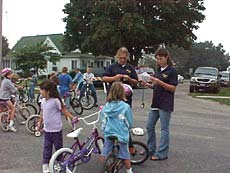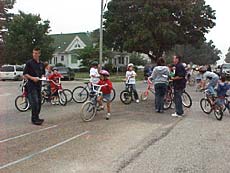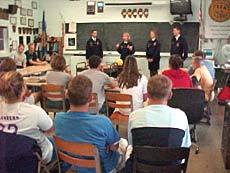|
Features,
Honors
& Awards, Ag
Announcements
Calendar,
Ag News Elsewhere
(fresh daily from the Web)
|
|
Features
|
|
Hartsburg corn plot results
[OCT.
14, 2002]
Fall brings with it many
reports of yields, from both fields and plots. Many of these yields
should be used together to select hybrids or varieties. Of course
your personal experience should also play a key role in selections.
Some of the value-added crops need to be looked at as well.
|
|
The Hartsburg Field was a cooperating
site this year in one of the studies of value-added traits for corn.
The same varieties were planted in multiple locations and will have
statistics and economic data run on them at the University of
Illinois. Grain samples will also be tested for specific traits. See
the chart below for the unofficial,
unreplicated yield numbers from Hartsburg without the value-added
economics. You can check on contract premiums if you are interested
in these varieties.
Other research projects at
the Hartsburg Field have been harvested and sent to campus for yield
data and analysis. These include nitrogen application based on amino
sugar test and nitrogen and manure application rates. You will
probably see some of this data at the winter agronomy offerings from
around the state.
[John
Fulton]
|

|
 |
|
|
Variety |
Trait |
Population |
Test weight |
Moisture |
Yield at 15% |
|
Adler 2650 |
Nutridense |
27000 |
60 |
16.3 |
131.15 |
|
Lewis 6002 |
Nutridense |
30000 |
58 |
16.2 |
132.47 |
|
Lewis 5072WX |
Waxy |
31000 |
60 |
15.8 |
172.80 |
|
Asgrow RX776 |
White |
26000 |
63 |
17.2 |
143.52 |
|
Burrus 582 |
Hard endosperm |
30000 |
59 |
14.5 |
158.87 |
|
QTI 4933 |
Hard endosperm |
31000 |
59 |
14.2 |
171.33 |
|
Wyffels W730 |
Hard endosperm |
31000 |
60 |
14.5 |
182.58 |
|
Adler 2700 |
High starch |
32000 |
57 |
13.0 |
159.25 |
|
QTI 4935 |
High starch |
30000 |
57 |
14.7 |
145.49 |
|
Wyffels 6570 |
High starch |
31000 |
57 |
14.0 |
151.45 |
|
Burrus 515P |
Conventional |
30000 |
58 |
12.4 |
157.92 |
|
Lewis 4830 |
Conventional |
29000 |
58 |
14.4 |
168.56 |
|
Golden Harvest H8906 |
Conventional |
30000 |
58 |
13.5 |
174.13 |
|
Pioneer 33P67 |
Conventional |
30000 |
60 |
15.9 |
197.09 |
|
|
 |
|
|
It’s
almost time for
first fall frost in Illinois
[OCT. 12, 2002]
Leaves
just starting to show some color, chrysanthemums and asters in
bloom, the beginning of the harvest season, and cooler night
temperatures all signal fall’s arrival in Illinois.
|
|
"The first fall frost usually occurs
between Oct. 7 (northern Illinois), Oct. 14 (central Illinois) and
Oct. 21 (southern Illinois). The Chicago area can expect frost by
Oct. 14, a week later than the rest of northern Illinois, probably a
result of the warmer urban setting and the moderating influence of
Lake Michigan," says Jim Angel, state climatologist with the
Illinois State Water Survey, a
division of the Illinois Department of Natural Resources.
The average frost date is based on
1971-2000 averages. Although the actual date varies quite a bit from
year to year, "frost usually occurs within two weeks of these
dates," says Angel.
"Despite concerns about global warming,
the first fall frost date has been occurring a little earlier at
most Illinois locations since the early 1970s, suggesting somewhat
cooler fall conditions," says Angel.
[to top of second column in
this article] |
Data from 13 long-term cooperative
observer sites in more rural locations throughout Illinois indicate
that the frost date is 16 days earlier in McLeansboro; 14 days
earlier in Anna and Champaign-Urbana; nine days earlier in Hoopeston
and Windsor; seven days earlier in Sparta; and five days earlier in
Marengo, Walnut and Minonk. This pattern appears to be prevalent
across Illinois, except for a slight trend toward frost three days
later in Carlinville (west-central), one day later in Rushville
(northeast), and no change in Mount Carroll and Aledo.
"There’s a
good chance that Indian summer, a warm, dry spell after the first
fall frost, will occur this year. If so, more mild weather will
follow," concludes Angel.
[Illinois State Water Survey
press release] |
|
|
Fall fertilization programs
require careful preparations
[OCT.
12, 2002]
URBANA — As the fall
harvest is completed, Illinois growers will soon turn to
preparations for next year’s crop. And, according to Bob Hoeft, soil
fertility specialist with University of Illinois Extension, one of
the most important steps is to carefully prepare a fall
fertilization program.
|
|
"Fall application of phosphorus is an
acceptable practice on all but the sandy soils in Illinois," Hoeft
said. "On sandy soils, it would be best to wait until spring to
apply potassium. There is danger that fall-applied potassium
fertilizer might leach down far enough so as to not be readily
available for the newly planted crops next spring."
He notes that phosphorus can be applied
on all soil types in the fall, because it will not leach even in
sandy soils.
"Most of the phosphorus fertilizer used
in Illinois is an ammoniated form, which contains nitrogen," he
said. "This material nitrifies somewhat slower than most other
nitrogen fertilizers, and there is limited risk of fall-applied
ammoniated phosphate being lost in the spring. Those materials are
not volatile and do not need to be incorporated into the soil."
Although applied nitrogen is acceptable
in the northern two-thirds of the state, growers should use caution
to ensure that the fertilizer has the greatest potential to be
available for next year’s crop and the least potential to be lost to
the environment. Those cautions include using the proper rate,
applying it at the right time and selecting materials that are
effective for fall application.
"University research has shown that,
over the long term, the proper rate is 1.2 pounds of nitrogen per
bushel of corn that the field will be expected to yield," Hoeft
said. "This represents the total amount of nitrogen needed for that
field. It is important to also take into account the amount of
nitrogen that will come from legumes, manure and urea-ammonium
nitrate solutions that might be applied with pesticides. All of
those contributions should be subtracted from base rate."
Hoeft notes that the nitrogen rate can
be reduced by 40 pounds per acre for corn planted after soybeans. At
least 50 percent of nitrogen from manure will also be available for
next year’s crop. Worksheets for figuring the rate are available in
the Illinois Agronomy Handbook and online at
http://web.aces.uiuc.edu/aim/IAH/ch11/nitro.html.
[to top of second column in this
article] |
"The majority of nitrogen in
fertilizers sold in Illinois comes in the ammonium form," he said.
"As long as it remains in that form, it is not susceptible to loss,
even in the wettest conditions. Once it converts to nitrate,
however, it becomes susceptible to denitrification and leaching
losses when soils become excessively wet."
He points out that the conversion of
ammonium to nitrate can be slowed by cool soils and the use of a
nitrification inhibitor.
"Growers should not apply fall nitrogen
for corn south of Illinois Route 16," Hoeft said. "North of that
line, growers should wait until soil temperatures are less than 60
degrees Fahrenheit if a nitrification inhibitor is used or 50
degrees if no inhibitor is used. Irregardless of soil temperature,
application should not start until Oct. 15 in the northern three
tiers of counties and Oct. 21 between the third tier of counties and
Route 16."
He notes that anhydrous ammonia is the
most stable fertilizer for fall application because it is injected
in a concentrated band. Ammonium sulfate can also be applied in the
fall, but its application should be delayed until the soils are at
or near freezing.
"If
possible, growers should wait until late November or early December
before applying ammonium sulfate," Hoeft said. "Urea or
urea-containing products for corn should not be applied in the fall
or winter. The risk of loss from fall or winter applications is
substantial even when those materials are incorporated."
[U of I news release]
|
|
|
4-H takes over county windows
[OCT.
11, 2002]
Logan County 4-H clubs
recently participated in a window display contest throughout the
county as part of National 4-H Week activities.
|
|
Clubs that participated and display
sites were Atlanta Town and Country, using a window at the Atlanta
Museum Annex; Chester 4-H, at Abe Lincoln’s General Store in
Lincoln; Cloverdale, Lincoln Red Cross office; Clover Kids, Deron
Powell’s State Farm Insurance in Mount Pulaski; Hartem Clovers,
Hartsburg State Bank; Middletown 4-H’ers, Middletown Junior High;
Millennium Clovers, Heads R Turnin’ in Lincoln; and Wide-A-Wake 4-H,
Action Rentals in Lincoln.
|
First place went to the Wide-A-Wake 4-H
club for their window display at the Action Rentals store on
Broadway Street in Lincoln. Second place was awarded to Hartem
Clovers for their display at Hartsburg State Bank, and third place
went to Cloverdale for their display at Lincoln’s Red Cross office.
In addition, the 4-H clubs had a poster
contest. Katie Turner, a member of the Hartem Clovers, was chosen as
the winner.
For
additional information about the 4-H program in Logan County,
individuals can contact the Logan County Extension office at
732-8289.
[News
release] |
|
|
Agriculture + fun = FFA
[OCT.
9, 2002]
Section 14 officers, along
with Meagan Wells, the 2002-2003 Illinois FFA treasurer, conducted
visits Sept. 30-Oct. 4 to chapters throughout the section.
|
|
As the group traveled to 11 schools,
Meagan presented a program on the many opportunities available in
the FFA. The section officers helped out by sharing their own
experiences and informing the members about various conferences and
activities. After the program, FFA members filled out a goal card,
as Meagan challenged them to set their goals high and strive to
reach them.
A week of chapter visits would not be
complete without Leadership Training School. On Wednesday, Oct. 2,
all of the Greenhand FFA members and chapter officers came together
at Athens High School for a night of learning and fun. The group was
honored to have Mr. Dave Mouser, a motivational speaker and past
state officer, to kick off the night.
Then, the section officer team took the
respective chapter officers into a training session on their duties
as officers. Meagan Wells stayed with the Greenhand members for a
motivational session. As everyone came back together, the section
officer team had a little bit of fun distinguishing the differences
in proper and improper official dress. A meal was served, and then
Meagan Wells gave her keynote address.
The week of
activities filled with chapter visits and leadership training was a
great success. The officers wish all of the FFA members in Section
14 and across the state the best of luck in accomplishing their
goals this year and in the future.
[FFA news release] [to top of
second column in this section] |

[Photos provided by FFA]

[The Hartsburg-Emden
FFA helped the Logan County Sheriff's Department with a bike rodeo
at the Emden School. The Sheriff’s Department explained to the kids
about proper safety when riding a bike on the road.]

[The Hartsburg-Emden
chapter received a visit Monday from section officers and the FFA
state treasurer.]

[Hartsburg-Emden FFA
officers and Greenhands attended Leadership Training School at
Athens High School.] |
|
|
Weekly outlook
Carry-over stocks
[OCT.
8, 2002]
URBANA — The calculation of
the availability of U.S. corn and soybeans for the current marketing
year may change with subsequent changes in the projected crop sizes,
said a University of Illinois Extension marketing specialist.
|
|
"Strength of demand will be gauged by
the rate of consumption as revealed in weekly, monthly and quarterly
reports and by the development of Southern Hemisphere crops," said
Darrel Good. "These developments will determine if current prices
and current price projections are too high or too low. The prospects
of small year-ending stocks of corn, soybeans and wheat — both in
the United States and the world — may have more implications for
prices next spring and summer than for current prices.
"Unless U.S. crop size is less than
currently projected or demand is much stronger, supplies are
probably large enough to satisfy consumption requirements for this
marketing year at current prices. However, the drawdown in inventory
that is currently expected would leave little or no reserves in case
of a shortfall in production next year. Attention will first focus
on growing conditions in South America and then to prospective
acreage and weather conditions in the United States."
Good’s comments came as he reviewed the
price implications of small carry-over stocks. The USDA projects
that stocks of U.S. corn and wheat at the end of the current year
will be the smallest in seven years. Stocks of soybeans are expected
to be reduced to the lowest level in six years. Based on the
projection of small inventories and on low ratios of projected
stocks to projected consumption, some analysts believe that current
prices are undervalued.
For example, Good noted, the projected
stocks-to-use ratio for corn is 7.5 percent, the lowest since
1995-96 (5 percent), when the U.S. average farm price was $3.24. For
the current year, the USDA projects the average price in a range of
$2.35 to $2.75. For soybeans, the projected stocks-to-use ratio is
about 6 percent, about the same as in 1996-97, when the U.S. average
farm price was $7.35. For the current year, the USDA projects the
average price in a range of $5.15 to $6.05.
"This type of comparison reveals the
shortcomings of the simplistic approach of trying to explain average
prices as a function of year-ending stocks," said Good. "In reality,
consumption, stocks and price are simultaneously determined. Once
crop size is known, maximum consumption during the crop year is
determined, based on the assumption of a minimum level of
year-ending stocks — probably between 4 and 5 percent of ‘normal’
annual consumption of corn and soybeans and about 15 percent for
wheat.
[to top of second column in
this article]
|
"The strength of demand, then,
determines the level of price required to match available supplies
with consumption. Strength of demand for U.S. crops is determined by
a number of factors, including the number of livestock being fed,
level of livestock prices, size of crop production in the rest of
the world, exchange rates, processing capacity and price of
processed goods, and U.S. and world economic conditions."
For corn, the current projection of
crop size indicates that if year-ending stocks were reduced to about
5 percent of normal consumption (about 500 million bushels), there
would be about 9.97 billion bushels of U.S. corn available for use
during the current marketing year.
"The largest annual consumption ever
experienced was the 9.817 billion bushels last year," said Good.
"Unless demand is much stronger than currently anticipated, there is
apparently an ample supply of U.S. corn at a ‘modest’ price."
For soybeans, the current U.S.
production forecast suggests that consumption during the current
year would be limited to about 2.724 million bushels if year-ending
stocks were reduced to about 5 percent of "normal" consumption (145
million bushels). That level of consumption is 209 million bushels,
or 7 percent, less than last year’s record consumption. The USDA
expects that consumption will be reduced as a result of higher
prices (an average of $5.15 to $6.05 compared to last year’s average
of $4.35) and weaker demand for U.S. soybeans. Much of the expected
weakness in demand is the result of the projection of a
240-million-bushel increase in South American soybean production in
2003.
For wheat, the USDA crop estimate
suggests that consumption of U.S. wheat during the current marketing
year would be limited to about 2.122 million bushels if year-ending
stocks were reduced to 360 million bushels. That is 47 million (2
percent) less than consumption during the previous year and about
280 million (12 percent) less than the average consumption of about
2.4 billion bushels during the 1990s.
"Demand for
U.S. wheat is expected to remain firm, due in part to unchanged
production in the rest of the world," said Good. "The USDA expects
that the reduction in consumption of U.S. wheat will be accomplished
by higher prices — an average between $3.45 and $4.05 compared to
last year’s average of $2.78."
[U
of I news release]
|
|
|
Honors
& Awards
|
|
|
Ag
Announcements
|
|